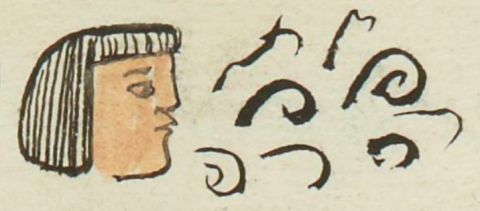Tlacuic (MH515r)
This black-line drawing of the simplex glyph for the personal name Tlacuic (perhaps "Singer," attested here as a man's name) shows the head of the man in question in profile facing toward the viewer's right. His skin is painted pink. Although his mouth is not open, eight scrolls emerge from the vicinity of the mouth. Given the element "cuic" in his name, it must be that he is meant to be singing something or has sung something, since (cuica is the verb to sing).
Stephanie Wood
The scrolls vary in the degree to which they curl, and they are simple curling lines compared to speech scrolls that are used for song and speaking in other glyphs in this collection (see below).
To have a personal name like Tlacuic (perhaps from tlacuica, to sing) may mean more than something occupational or some time of sounds emitted as a baby. Bierhorst's Ballads of the Lords of New Spain (2010, 38) gives some examples of people equated with being a song: "I come created as a song, come fashioned as a song," "As a song you've been born, O Montezuma: as a flower you've come to bloom on earth," and "As songs you've come alive, as flowers you've blossomed, O princes."
antonio tlacuic
Antonio Tlacuic
Stephanie Wood
1560
Jeff Haskett-Wood
songs, canciones, cantar, to sing, nombres de hombres

cuica, to sing, https://nahuatl.wired-humanities.org/content/cuica
Matrícula de Huexotzinco, folio 515r, World Digital Library, https://www.loc.gov/resource/gdcwdl.wdl_15282/?sp=109&st=image
This manuscript is hosted by the Library of Congress and the World Digital Library; used here with the Creative Commons, “Attribution-NonCommercial-ShareAlike 3.0 License” (CC-BY-NC-SAq 3.0).





